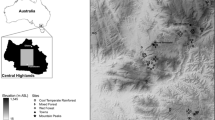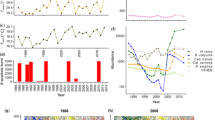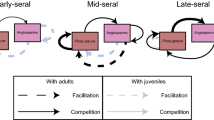Abstract
Fine-scale spatial structure is an essential feature of plant populations, controlling pollination, herbivory, pathogen spread, and resource partitioning. Origins of spatial distribution are often obscure in long-established forests, but successional stands offer insight through their physical and compositional simplicity. We tested the hypothesis that spatial structure in forest herb populations arises through a nucleation process in which colonizing species transition from random to clustered distributions through clonal expansion, seed dispersal, and conformity to environmental gradients. Spatial structure was examined in a chronosequence of 40 s growth stands in southeast Ohio, USA. Herbaceous vegetation was recorded in nested plots to describe the evolution of pattern across multiple scales. Spatial distribution was described as the variance:mean ratio of stem number plot-1, and compared between age classes and functional groups. Environmental influence was assessed as the marginal R2 value of environmental models predicting stem number. Herb species responded individualistically to stand age and environmental gradients, although all were to some degree clustered across age classes. Dispersal-limited, non-clonal, and annual species were most strongly clustered, suggesting the importance of seed dispersal range and population growth rate in determining spatial structure. Spatial distribution was weakly related to environmental variables. Clustered distributions established early in succession and remained stable for at least 80 years. Pattern formation can be interpreted in terms of nucleation, as we hypothesized, but clusters form earlier than expected. The spatial structure of herb populations in deciduous forests appears to be governed by patterns established during colonization; environmental filtering appears to play a minor role.




Similar content being viewed by others
References
Alexander HM, Foster BL, Ballantyne F, Collins CD, Antonovics J, Holt RD (2012) Metapopulations and metacommunities: combining spatial and temporal perspectives in plant ecology. J Ecol 100:88–103. https://doi.org/10.1111/j.1365-2745.2011.01917.x
Armesto JJ, Pickett STA, McDonnell MJ (1991) Spatial heterogeneity during succession: a cyclic model of invasion and exclusion. In: Kolasa J, Pickett STA (eds) Ecological Heterogeneity. Springer, New York, pp 256–269
Augspurger C (1984) Seedling survival of tropical tree species: interactions of dispersal distance, light-gaps, and pathogens. Ecology 65:1705–1712. https://doi.org/10.2307/1937766
Baeten L, Hermy M, Verheyen K (2009) Environmental limitation contributes to the differential colonization capacity of two forest herbs. J Veg Sci 20:209–223. https://doi.org/10.1111/j.1654-1103.2009.05595.x
Baeten L, Verstraeten G, Frenne P, Vanhellemont M, Wuyts K, Hermy M, Verheyen K (2011) Former land use affects the nitrogen and phosphorus concentrations and biomass of forest herbs. Plant Ecol 212:901–909
Barret SCH, Thompson JD (1982) Spatial pattern, floral sex ratios, and fecundity in dioecious Aralia nudicaulis (Araliaceae). Can J Bot 60:1662–1670. https://doi.org/10.1139/b82-216
Barton K, Barton MK (2015) Package ‘MuMIn’. Version 1, 18
Batch CE (1984) Plant spatial pattern and herbivore population dynamics: plant factors affecting the movement patterns of a tropical cucurbit specialist (Acalymma innubum). Ecology 65:175–190. https://doi.org/10.2307/1939469
Bates D, Maechler M, Bolker B, Walker S (2015) Fitting linear mixed-effects models using lme4. J Stat Softw 67:1–48
Beatty SW (1984) Influence of microtopography and canopy species on spatial patterns of forest understory plants. Ecology 65:1406–1419. https://doi.org/10.2307/1939121
Bell AD, Tomlinson PB (1980) Adaptive architecture in rhizomatous plants. Bot J Linnean Soc 80:125–160. https://doi.org/10.1111/j.1095-8339.1980.tb01662.x
Bloom AJ, Chapin FS III, Mooney HA (1985) Resource limitation in plants: an economic analogy. Ann Rev Ecol Syst 16:363–392. https://doi.org/10.1146/annurev.es.16.110185.002051
Braun EL (1950) Deciduous forests of North America. The Blankiston Company, Philadelphia
Brockman S (1998) Physiographic regions of Ohio. Division of Geological Survey, Columbus
Brunet J, Von Oheimb G (1998) Migration of vascular plants to secondary woodlands in southern Sweden. J Ecol 86:429–438. https://doi.org/10.1046/j.1365-2745.1998.00269.x
Christen DC, Matlack GR (2006) The habitat and conduit functions of roads in the spread of three invasive plant species. Biol Inv 11:453–465
Cutler NA, Belyea LR, Dugmore AJ (2008) Spatial patterns of microsite colonization on two young lava flows on Mount Hekla, Iceland. J Veg Sci 19:277–286. https://doi.org/10.3170/2008-8-18371
Del Moral R, Wood DM (1993) Early primary succession on a barren volcanic plain at Mount St. Helens, Washington. Am J Bot 80:981–991. https://doi.org/10.1002/j.1537-2197.1993.tb15324.x
Dessaint F, Chadoeuf R, Barralis G (1991) Spatial pattern analysis of weed seeds in the cultivated soil seed bank. J App Ecol 28:721–730. https://doi.org/10.2307/2404578
Development Core Team (2017) R: a language and environment for statistical computing. R Foundation for Statistical Computing, Vienna
Edwards J (1984) Spatial pattern and clone structure of the perennial herb, Aralia nudicaulis L. (Araliaceae). Bull Torrey Bot Club 111:28–33. https://doi.org/10.2307/2996207
Ehrlén J, Eriksson O (2000) Dispersal limitation and patch occupancy in forest herbs. Ecology 81:1667–1674. https://doi.org/10.1890/0012-9658(2000)081%5b1667:DLAPOI%5d2.0.CO;2
Elliott JM, Decamps H (1973) Guide pour l’analyse statistique des échantillons d’invertébrés benthiques. Limnologie 9:79–120. https://doi.org/10.1051/limn/1973001
Fenneman NM, Johnson DW (1946) Physiographic divisions of the conterminous United States. US Geological Survey, Reston
Flinn KM (2007) Microsite-limited recruitment controls fern colonization of post-agricultural forests. Ecology 88:3103–3114. https://doi.org/10.1890/06-2124.1
Fraterrigo JM, Turner MG, Pearson SM, Dixon P (2005) Effects of past land-use on spatial heterogeneity of soil nutrients in southern Appalachian forests. Ecol Monographs 75:215–230. https://doi.org/10.1890/03-0475
Ghazoul J (2005) Pollen and seed dispersal among dispersed plants. Biol Rev 80:413–443. https://doi.org/10.1017/s1464793105006731
Gilbert B, Lechowicz MJ (2004) Neutrality, niches, and dispersal in a temperate forest understory. Proc Natl Acad Sci 101:7651–7656. https://doi.org/10.1073/pnas.0400814101
Goebel PC, Hix DM, Semko-Duncan M (2005) Composition and structure of two old-growth forest ecosystem types of Southeastern Ohio. Ohio J Sci 105:8–16
Grashof-Bokdam C, Geertsema W (1998) The effect of isolation and history on colonization patterns of plant species in secondary woodland. J Biogeogr 25:837–846
Greig Smith P (1983) Quantitative plant ecology, 3rd edn. Blackwell, Oxford
Handel SN (1983) Pollination ecology, plant population structure, and gene flow. Pollination Biol 163:211. https://doi.org/10.1046/j.1365-2699.1998.00225.x
Hansen MC (2017) The ice age in Ohio. Educational Leaflet Number 7, Revised Edition, Division of Geological Survey, Ohio Department of Natural Resources
Harper JL (1977) Population biology of plants. Academic Press, New York
Harrelson SM, Matlack GR (2006) Influence of stand age and physical environment on the herb composition of second-growth forest, Strouds Run, Ohio, USA. J Biogeogr 33:1139–1149. https://doi.org/10.1111/j.1365-2699.2006.01489.x
Hermy M, Verheyen K (2007) Legacies of the past in the present-day forest biodiversity: a review of past land-use effects on forest plant species composition and diversity. In: Nakashizuka T (ed) Sustainability and diversity of forest ecosystems. Springer, Tokyo
Hicks DJ (1980) Intrastand distribution patterns of southern Appalachian cove forest herbaceous species. Am Midland Naturalist 104:209–223. https://doi.org/10.2307/2424861
Holmes MA, Matlack GR (2017a) Agricultural history drives structure and tree species composition of second growth forest over 100 years in southeastern Ohio, USA. J Veg Sci 28:736–746. https://doi.org/10.1111/jvs.12516
Holmes MA, Matlack GR (2017b) Forest micro-environment develops through time: changes in physical and structural heterogeneity follow abandonment from two forms of agriculture. For Ecol Manag 404:55–64. https://doi.org/10.1016/j.foreco.2017.08.034
Holmes MA, Matlack GR (2018) Assembling the forest herb community after abandonment from agriculture: long-term successional dynamics differ with land-use history. J Ecol 106:2121–2131. https://doi.org/10.1111/1365-2745.12970
Horvitz CC, Le Corff J (1993) Spatial scale and dispersion pattern of ant- and bird-dispersed herbs in two tropical lowland rainforests. Vegetation 107(108):351–362
Hougen KE, Matlack GR (2012) Long-term effects on vegetation and soils at two 19th century iron furnace sites in southeastern Ohio, USA. For Ecol Manag 269:279–292. https://doi.org/10.1016/j.foreco.2012.01.001
Huebner CD, Randolph JC (1995) Environmental factors affecting understory diversity in second-growth forests. Am Midland Naturalist 134:155–265. https://doi.org/10.2307/2426492
Hughes JW, Fahey TJ (1991) Colonization dynamics of herbs and shrubs in a disturbed Northern Hardwood forest. J Ecol 79:605–616. https://doi.org/10.2307/2260656
Hurlburt SH (1990) Spatial distribution of the montane unicorn. Oikos 58:257–271. https://doi.org/10.2307/3545216
Jacquemyn H, Brys R (2008) Effects of stand age on the demography of a temperate forest herb in post-agricultural forests. Ecology 89:3480–3489. https://doi.org/10.1890/07-1908.1
Jacquemyn H, Brys R, Honnay O, Hermy M, Roldán-Ruiz I (2005) Local forest environment largely affects below-ground growth, clonal diversity and fine scale spatial genetic structure in the temperate deciduous forest herb Paris quadrifolia. Mol Ecol 14:4479–4488. https://doi.org/10.1111/j.1365-294X.2005.02741.x
Lucht TE, Anderson KM, Brown DL, Martin NN (1985) Soil Survey of Athens County Ohio. Soil Conservation Service, US Department of Agriculture, Government Printing Office, Washington, DC
Matlack GR (1994a) Vegetation dynamics of the forest edge-trends in space and successional time. J Ecol 82:113–123. https://doi.org/10.2307/2261391
Matlack GR (1994b) Plant species migration in a mixed-history forest landscape in eastern North America. Ecology 75:1491–1502. https://doi.org/10.2307/1937472
Menges ES (1986) Environmental correlates of herb species composition in five southern Wisconsin floodplain forests. Am Midland Naturalist 115:106–117. https://doi.org/10.2307/2425840
Miller TF, Mladenoff DJ, Clayton MK (2002) Old-growth Northern Hardwood forests: spatial autocorrelation and patterns of understory vegetation. Ecol Monographs 72:487–503. https://doi.org/10.1890/0012-9615(2002)072%5b0487:OGNHFS%5d2.0.CO;2
Monsted J (2018) Land use history as a driver of second-growth forest composition in Southeastern Ohio. Masters Thesis, Department of Environmental and Plant Biology. Ohio University, Athens, Ohio, USA
Mooney HA, Hobbs RJ (1985) Resilience at the level of the individual plant. In: Dell B (ed) Resilience in mediterranean ecosystems. Junk, The Hague
Nakagawa S, Schielzeth H (2013) A general and simple method for obtaining R 2 from generalized linear mixed-effects models. Methods Ecol Evol 4:133–142. https://doi.org/10.1111/j.2041-210x.2012.00261.x
Neufeld HS, Young DR (2003) Ecophysiology of the herbaceous layer in temperate deciduous forests. In: Gilliam FS, Roberts MR (eds) The herbaceous layer in forests of eastern North America. Oxford University Press, Oxford
Niederhauser EC, Matlack GR (2017) Do deer and raccoons defecate in the right place? Fitness consequences of vertebrate seed dispersal for a deciduous forest herb. Oecologia 3:727–737
Nuttle T, Ristau TE, Royo AA (2014) Long-term biological legacies of herbivore density in a landscape-scale experiment: forest understoreys reflect past deer density treatments for at least 20 years. J Ecol 102:221–228. https://doi.org/10.1111/1365-2745.12175
Olivero AM, Hix DM (1998) Influence of aspect and stand age on ground flora of southeastern Ohio forest ecosystems. Plant Ecol 139:177
Parks JC, Werth CR (1993) A study of spatial features of clones in a population of bracken fern, Pteridium aquilinum (Dennstaedtiaceae). Am J Bot 80:537–544. https://doi.org/10.1002/j.1537-2197.1993.tb13837.x
Pickett STA (1989) Space-for-time substitution as an alternative to long-term studies. In: Likens GE (ed) Long-term studies in ecology. Springer, New York
Pimentel D (1961) The influence of plant spatial patterns on insect populations. Ann Ent Soc Am 54:61–69. https://doi.org/10.1093/aesa/54.1.61
Struik GJ (1965) Growth patterns of some native annual and perennial herbs in southern Wisconsin. Ecology 46:401–420. https://doi.org/10.2307/1934873
Totland O, Nielsen A, Bjerknes AL, Ohlson M (2006) Effects of an exotic plant and habitat disturbance on pollinator visitation and reproduction in a boreal forest herb. Am J Bot 93:868–873. https://doi.org/10.3732/ajb.93.6.868
Turkington R, Harper JL (1979) The growth, distribution and neighbour relationships of Trifolium repens in a permanent pasture: IV. Fine-scale biotic differentiation. J Ecol 67:245–254. https://doi.org/10.2307/2259348
USGS (2016) Earth explorer. http://earthexplorer.usgs.gov/. Accessed 1 Nov 2014
van der Maarel E, Sykes MT (1993) Small-scale plant species turnover in a limestone grassland: the carousel model and some comments on the niche concept. J Veg Sci 4:179–188. https://doi.org/10.2307/3236103
Vellend M, Verheyen K, Flinn KM, Jacquemyn H, Kolb A, Van Calster H, Peterken G, Graae BJ, Bellemare J, Honnay O, Brunet J (2007) Homogenization of forest plant communities and weakening of species–environment relationships via agricultural land-use. J Ecol 95:565–573. https://doi.org/10.1111/j.1365-2745.2007.01233.x
Venables WN, Ripley BD (2002) Modern applied statistics with R, 4th edn. Springer, New York
Verheyen K, Guntenspergen GR, Biesbrouck B, Hermy M (2003) An integrated analysis of the effects of past land-use on forest herb colonization at the landscape scale. J Ecol 91:731–742. https://doi.org/10.1046/j.1365-2745.2003.00807.x
Watt AS (1947) Pattern and process in the plant community. J Ecol 35:1–22. https://doi.org/10.2307/2256497
Weiner J, Stoll P, Muller Landau H, Jasentuliyana A (2001) The effects of density, spatial pattern, and competitive symmetry on size variation in simulated plant populations. Am Naturalist 158:438–450. https://doi.org/10.1086/321988
Wessels T (2010) Forest forensics: a field guide to reading the forested landscape. The Countryman Press, Woodstock
Yarranton GA, Morrison RG (1974) Spatial dynamics of a primary succession: nucleation. J Ecol 62:417–428. https://doi.org/10.2307/2258988
Zhou H, Chen J, Chen F (2007) Ant-mediated seed dispersal contributes to the local spatial pattern and genetic structure of Globba lancangensis (Zingiberaceae). J Heredity 98:317–324. https://doi.org/10.1093/jhered/esm032
Acknowledgements
The authors acknowledge the Philadelphia Botanical Club and the Ohio Center for Ecology and Evolutionary Studies for funding, and the Ohio Department of Natural Resources for site access.
Author information
Authors and Affiliations
Contributions
MAH and GRM conceived and designed the project; MAH collected and analyzed the data and led the writing of the manuscript. Both authors contributed critically to the drafts and gave final approval for publication.
Corresponding author
Ethics declarations
Conflict of interest
The authors declare that they have no conflict of interest.
Additional information
Communicated by Kendi Davies.
Appendices
Appendix 1
See Table 1.
Appendix 2
See Fig. 5.
Variance:mean ratio (VMR) at the 1 m plot scale through time for herbaceous species in a chronosequence of post-agricultural forest stands. Values above 1 indicate clustering within sites, values of 1 indicate randomness, and values below 1 indicate a regular distribution. P values obtained through regression of VMR against stand age
Appendix 3
See Fig. 6.
Appendix 4
See Table 2.
Appendix 5
See Table 3.
Rights and permissions
About this article
Cite this article
Holmes, M.A., Matlack, G.R. Spatial structure develops early in forest herb populations, controlled by dispersal and life cycle. Oecologia 189, 951–970 (2019). https://doi.org/10.1007/s00442-019-04380-6
Received:
Accepted:
Published:
Issue Date:
DOI: https://doi.org/10.1007/s00442-019-04380-6






